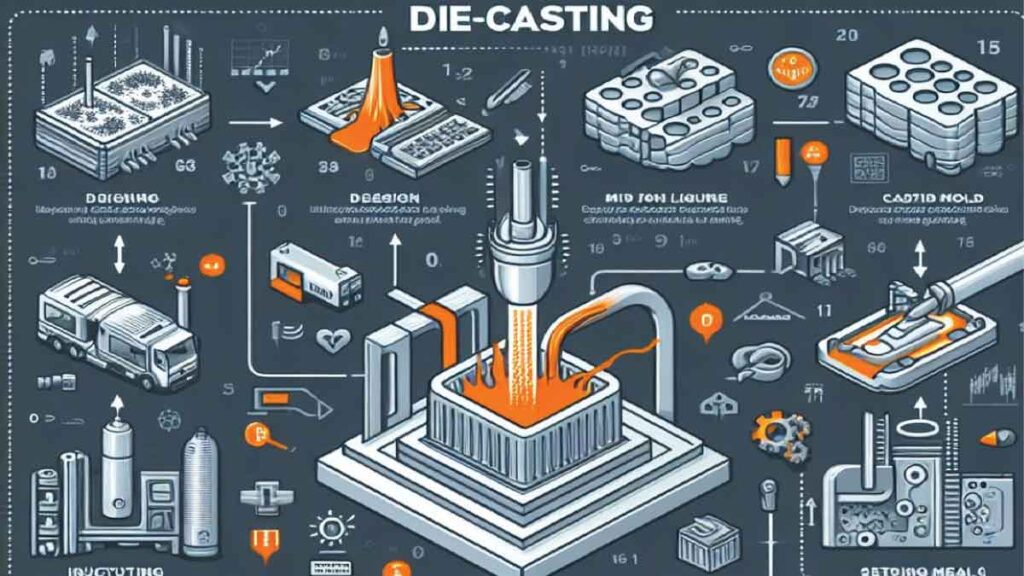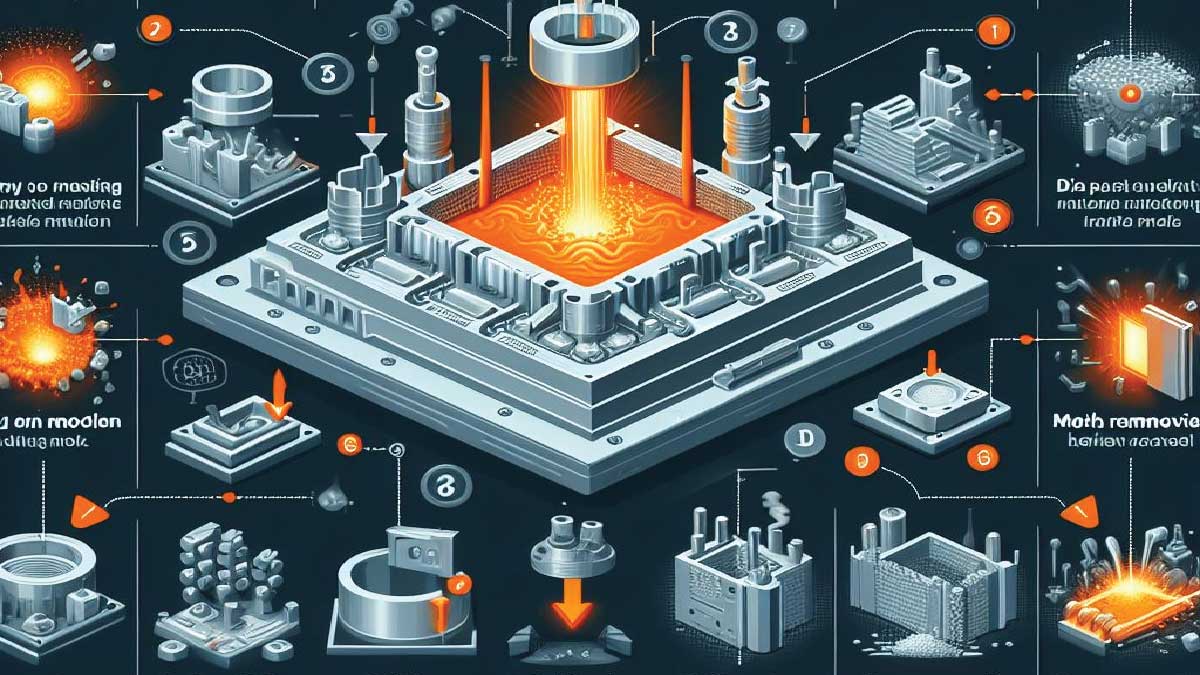Die casting process is a highly efficient and versatile manufacturing method used to create metal parts with high precision and intricate details. From automotive components to consumer electronics, die casting plays a crucial role in various industries. Understanding the die casting process is essential for engineers, designers, and manufacturers seeking to leverage its benefits. In this comprehensive guide, we’ll walk you through ten easy steps to demystify the intricacies of die casting and empower you to harness its full potential.
Step 1: Designing the Mold
The die casting process begins with designing the mold, also known as the die. This crucial step involves creating a precise blueprint of the desired part, taking into account factors such as part geometry, draft angles, and material flow. Computer-Aided Design (CAD) software is often used to create detailed mold designs that meet the required specifications. The mold design must also incorporate features such as runners, gates, and ejector pins to facilitate the casting process and ensure optimal part quality.
Step 2: Material Selection
Choosing the right material is paramount in die casting process. Common materials used include aluminum, zinc, and magnesium alloys, each offering unique properties such as strength, durability, and thermal conductivity. The material selection process involves considering factors such as part function, operating environment, and cost constraints. Conducting thorough material testing and analysis ensures that the chosen material meets the performance requirements of the final part.
Step 3: Melting the Metal
Once the mold is designed and the material selected, the next step is melting the metal. In die casting, the chosen metal is melted in a furnace and then injected into the mold under high pressure. The temperature and viscosity of the molten metal must be carefully controlled to ensure proper flow and fill of the mold cavity. Advanced temperature monitoring systems and precise control mechanisms are employed to achieve consistent results and minimize defects.
Step 4: Injecting the Metal into the Mold
With the metal melted to the desired temperature, it is injected into the mold cavity under high pressure. This step requires precision and control to ensure uniform filling of the mold and proper distribution of the metal throughout the cavity. The injection process is monitored closely to detect any anomalies or deviations from the desired parameters, allowing for immediate adjustments to maintain quality and consistency.
Step 5: Cooling and Solidification
As the molten metal fills the mold cavity, it begins to cool and solidify into the desired shape. The cooling rate is critical in die casting process, as it affects the microstructure and mechanical properties of the final part. To control the cooling rate, the mold is equipped with cooling channels through which coolant is circulated. This helps to dissipate heat quickly and ensure uniform cooling, minimizing the risk of defects such as porosity or shrinkage.
Step 6: Ejecting the Casting
Once the metal has solidified, the next step is ejecting the casting from the mold. This is accomplished using ejector pins or plates that push the casting out of the mold cavity. Care must be taken to prevent damage to the casting or the mold during ejection, as even minor imperfections can affect the part’s functionality or aesthetics. Automated ejection systems are often employed to ensure consistent and reliable part removal.
Related Posts:
10 Types of File Tools (Pictures): Materials and Uses
40 Different Types of Pliers and Their Uses
Step 7: Trimming and Finishing
After ejection, the casting may require additional trimming and finishing to remove excess material or improve surface quality. Trimming involves removing any excess metal, known as flash, that may have formed along the parting line of the mold. Finishing operations such as machining, grinding, or shot blasting may also be performed to achieve the desired dimensional accuracy and surface finish.
Step 8: Quality Inspection
Quality inspection is a critical step in the die casting process to ensure that the finished parts meet the required specifications and standards. Inspection techniques may include dimensional measurement, visual inspection, and non-destructive testing methods such as X-ray or ultrasound. Any defects or deviations from the specified tolerances are identified and addressed promptly to maintain product quality and integrity.
Step 9: Surface Treatment
Depending on the application requirements, the finished parts may undergo surface treatment processes to enhance their appearance, corrosion resistance, or other properties. Common surface treatments include painting, powder coating, anodizing, and plating. These treatments not only improve the aesthetic appeal of the parts but also provide additional protection against environmental factors and wear.
Step 10: Final Assembly
In some cases, die-cast parts may require final assembly with other components to form a complete product. This could involve welding, fastening, or adhesive bonding to join the parts together. Assembly operations are performed with precision to ensure proper fit and functionality of the finished product.

Conclusion
Understanding the die casting process is essential for anyone involved in manufacturing, engineering, or design. By following these ten easy steps, you can gain a comprehensive understanding of the intricacies involved and harness the full potential of die casting for your projects. Whether you are creating automotive components, electronic enclosures, or consumer goods, mastering the die casting process opens up a world of possibilities for innovation and success.
What is die casting?
Die casting is a manufacturing process that involves injecting molten metal into a reusable mold cavity, called a die, under high pressure. This results in the rapid and precise production of complex metal parts with tight tolerances and excellent surface finishes.
What materials are commonly used in die casting?
Common materials used in die casting include aluminum, zinc, and magnesium alloys. These materials offer a combination of strength, durability, and lightweight properties, making them ideal for a wide range of applications.
What are the advantages of die casting?
Die casting offers several advantages, including high production efficiency, dimensional accuracy, and the ability to produce complex shapes with thin walls and intricate details. Additionally, die cast parts have excellent surface finishes and can be produced with minimal post-processing.
What industries use die casting?
Die casting is widely used in industries such as automotive, aerospace, electronics, and consumer goods manufacturing. It is commonly employed for producing components such as engine parts, housings, brackets, and electronic enclosures.
What are the different types of die casting?
The two main types of die casting are hot chamber die casting and cold chamber die casting. Hot chamber die casting is suitable for low-melting-point metals like zinc, while cold chamber die casting is used for high-melting-point metals like aluminum and magnesium.
What is the difference between die casting and other casting methods?
Unlike other casting methods that use expendable molds, die casting utilizes reusable molds, known as dies. Additionally, die casting involves injecting molten metal into the mold under high pressure, resulting in faster production cycles and superior part quality.
What factors influence the cost of die casting?
Several factors influence the cost of die casting, including the complexity of the part design, the choice of material, the size and weight of the part, and the required production volume. Additionally, tooling costs for creating the dies and post-processing requirements can also impact overall die casting costs.

HA Chaudhary is an experienced engineer with 15 years in the mechanical and industrial sectors. Holding advanced degrees and multiple certifications in engineering, he combines technical expertise with a passion for writing to provide valuable insights into engineering innovations and business strategies. His content empowers professionals to excel in their fields and stay updated with the latest industry trends.

